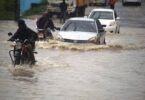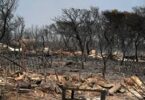Nick Robertson
As heat waves become more common due to changes in climate, they are likely to be deadlier and more damaging in regions which haven’t yet faced extreme heat, according to a new study in Nature Communications.
The British researchers found that Central America and Afghanistan are among the parts of the world most likely to be damaged by increasing heat, due to a lack of preparation in those regions and historical trends which haven’t seen as many extreme heat events before.
“Often, regions are only prepared for events as extreme as they have already experienced, with planning initiated by past disasters. Policymakers and governments need to prepare for events beyond current records – particularly with trends caused by anthropogenic climate change enhancing the probability of extremes,” the research says.
The study closely looked at the 2021 Pacific Northwest heatwave, which saw temperatures well over 100 degrees reach Portland, Seattle and Vancouver. A temperature of 121 degrees was cited in British Columbia, capping an extreme heat event which killed hundreds.
The heatwave was so far beyond what would be expected that it doesn’t fit standard climate projection models, the researchers said. The study found that about 30 percent of the world has experienced record heat that shouldn’t be possible, given current models.
However, the study noted that parts of the world that have not experienced those extreme heat events are now more susceptible to them, because they are not likely to be prepared. They are also more likely to experience record-breaking heat because their records are lower.
Researchers also used economic and population data to determine which regions are at the most risk going forward.
The region of “most concern,” researchers said, is Afghanistan, due to the country having a high likelihood of breaking its heat record sooner than other regions, and the lack of infrastructure and preparation for such events.
The country has been devastated by war for decades, and the country suffers from a lack of advanced medical and power infrastructure, potentially making an extreme heat event more fatal.
The Central American nations of Guatemala, El Salvador, Honduras, Nicaragua, Costa Rica, and Panama are also at high risk because despite rapid development in those countries, climate trends pointing to a “large jump” in heat records in the region outpace the development in these nations’ utility infrastructures, according to the study. This makes it more likely for the region to suffer devastation following extreme heat waves.
Northern China, near Beijing, and Central Europe are also regions of risk but are less likely to see devastating outcomes because those nations are likely to be better equipped to prepare for and mitigate the impacts of extreme heat, researchers said.
The European nations most at risk for extreme heat and its impacts are the Netherlands, Belgium and Germany.
“In these regions, a record-breaking event is not only more likely but also likely to have greater impacts due to a lack of preparedness,” the study says. “Countries tend to prepare to the level of the greatest event they have experienced within collective memory.”
Exceptional heat waves have occurred all over the world with no trend in location or time, meaning that “everywhere needs to be prepared” for an extreme heat event at any time, as the 2021 Pacific Northwest heatwave demonstrated, the researchers said.
The study found that proper preparation can be very effective in mitigating the human cost of extreme heat waves. Researchers encouraged national and local governments to make heat wave plans including public cooling centers and reducing working hours outdoors, measures the CDC has lauded as effective.
Courtesy: thehill







